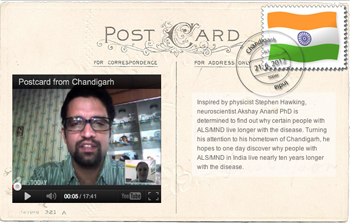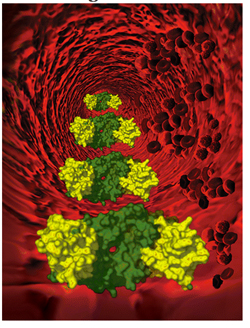
Postcard from Chandigarh. Akshay Anand PhD talks about how he hopes to discover the secret behind the longevity of certain people with ALS/MND.
Inspired by physicist Stephen Hawking, Post Graduate Institute of Medical Education and Research (PGIMER) neuroscientist Akshay Anand PhD is determined to find out why certain people with ALS live longer with the disease. Turning his attention to his hometown of Chandigarh, he hopes to discover why people with ALS in India live nearly ten years longer with the disease.
He suspected that higher levels of the blood vessel-forming substance VEGF could be a possible reason people from India live longer with ALS. Lower levels of VEGF appear to increase the risk of getting ALS. And, reduced VEGF according to preclinical studies results in neurodegenerative disease.
“All neurons would be happy to have more supply of nutrients coming from blood vessels,” explains Anand. “Any disruption in the supply of blood [however] could lead to neurodegeneration.”

Soakin' Up the VEGF. Blood vessels are formed at the right place and at the right time in part by restricting the levels of VEGF (yellow) available through the VEGF scavanger receptor VEGF-R1/FLT1 (green). Image: Journal of Biological Chemistry.
To put his theory to the test, he teamed up with PGIMER neurologist Sudesh Pradhakar MD to take a look at levels of VEGF circulating in people with ALS. The researchers focused on 100 people from Northern India – including 50 people with ALS. The team found that the levels of VEGF appeared to be more than three-times higher in the spinal cord of people with definite ALS compared to people without the disease.
These results suggested that increased nourishment, delivered by additional blood vessels via astrocytes, may help ALS-ravaged motor neurons stay alive longer, slowing down the disease.
The team subsequently found, in a study that included 36 people with ALS from Northern India, that the boost in VEGF might be explained by reduced levels of the VEGF “sponge” VEGF-R1/FLT1.
Now, the PGIMER team hopes to look at more people with ALS to determine whether or not circulating levels of VEGF or VEGF-R1/FLT1 correlate with the stage and severity of the disease. And, at the same time, evaluate whether VEGF-R1/FLT1 could be used as a biomarker to identify people who live longer with the disease.
“Who knows? This could be the molecule,” says Anand. “The suppression, reduction or inhibition [of VEGF-R1/FLT1] could actually if not curb the fatality of the disease, at least extend the survival time.”
References
Anand, A., Gupta, P.K., Sharma, N.K. and Prabhakar, S. (2012) Soluble VEGFR1 (sVEGFR1) as a novel marker of amyotrophic lateral sclerosis (ALS) in the North Indian ALS patients. European Journal of Neurology 19(5), 788-792. Abstract | Full Text
Gupta, P.K., Prabhakar, S., Sharma, S. and Anand A. (2011) Vascular endothelial growth factor-A (VEGF-A) and chemokine ligand-2 (CCL2) in amyotrophic lateral sclerosis (ALS) patients. Journal of Neuroinflammation 8, 47. Abstract | Full Text
Gupta, P.K., Prabhakar, S., Abburi, C., Sharma, N.K. and Anand A. (2011) Vascular endothelial growth factor-A and chemokine ligand (CCL2) genes are upregulated in peripheral blood mononuclear cells in Indian amyotrophic lateral sclerosis patients. Journal of Neuroinflammation 8, 114. Abstract | Full Text
Lambrechts, D. et al. (2003) VEGF is a modifier of amyotrophic lateral sclerosis in mice and humans and protects motoneurons against ischemic death. Nature Genetics 34(4), 383-394. Abstract | Full Text (Subscription Required)
Oosthuyse, B. et al. (2001) Deletion of the hypoxia-response element in the vascular endothelial growth factor promoter causes motor neuron degeneration. Nature Genetics 28(2): 131-138. Abstract | Full Text (Subscription Required)